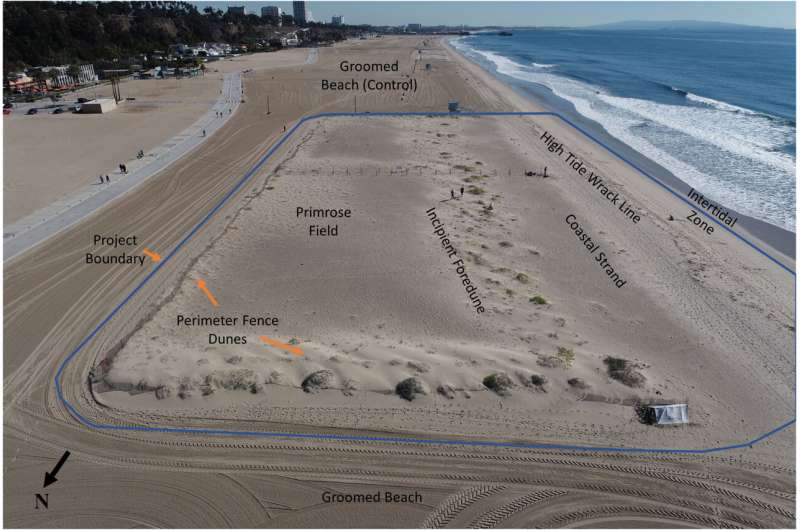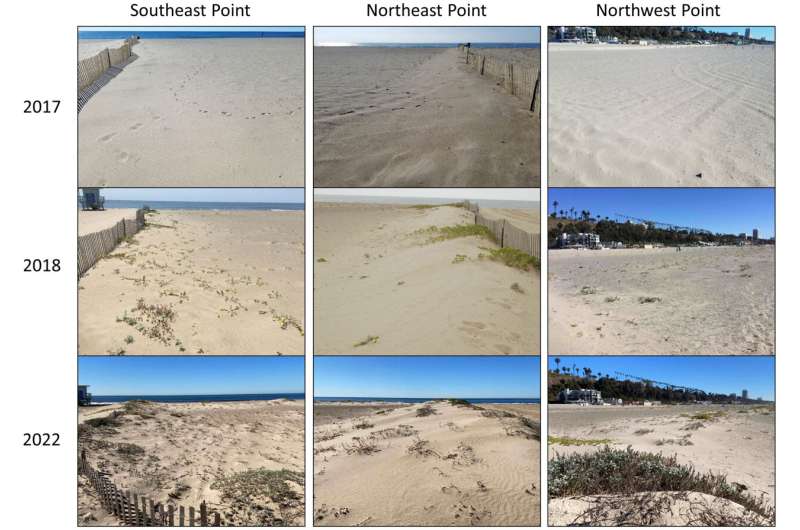June 22, 2023 feature
This article has been reviewed according to Science X's editorial process and policies. Editors have highlighted the following attributes while ensuring the content's credibility:
fact-checked
peer-reviewed publication
trusted source
proofread
Coastal erosion could be reduced by dune restoration projects

Although sand dunes often conjure images of great deserts, they also occur along coastlines worldwide and can be an important buffer for communities threatened by sea level rise, storms and coastal erosion.
Coastal sand dunes trap sediment, encouraging expansion instead of erosion, while plants can act as magnets for wind-blown sand, anchoring the grains to the developing dune and helping to build resilience against the forces of nature. Such an environment then assists the opening of ecological space in urban areas, encouraging biodiversity of both plant and animal species.
More than 45% of southern California's coastline is groomed with machinery used to remove debris from sandy beaches, creating a flat topography ideal for recreational activities of the local population and tourists. However, vegetation is consequently actively discouraged from growing, reducing habitats for local wildlife and resulting in some native and threated species becoming locally extinct.
To consider how a nature-based approach may help urban coastal erosion, researchers at the University of California's Marine Science Institute and their collaborators selected a 12,000 m2 site on Santa Monica Beach, Los Angeles, in December 2016 and monitored restoration of the area over six years. This research, published in Frontiers in Marine Science, was also designed to test a more sustainable and cost-effective approach to coastal resilience compared to traditional defense barriers.

The site had previously been intensively groomed and nourished by bringing sediment from other localities to make the beach larger, but the restoration project ceased this activity, erected fencing on three sides to trap sand with an opening to the ocean, and planted seeds of native dune plants. This included species such as Abronia maritima (red sand verbena), Ambrosia chamissonis (beach bur), Atriplex leucophylla (beach salt bush) and Camissoniopsis cheiranthifolia (beach evening primrose), the first two of which are engineer species known to actively impact the biological diversity of their ecosystem. The dune was then monitored for sand accretion (making the dune and beach larger), as well as biological activity in the form of plant development and wildlife introductions.
Within one month of erecting the fences, the researchers measured the beginning of sand being accreted and dune formation (eventually reaching 15 cm in six months), and plants began to germinate within two months. By August 2021, the volume of sand had increased an astonishing 30 m3 per meter of shoreline.
Over the six-year period, they found that approximately 1,730 m3 of sand had accreted onto the site, with the dune elevating 1 m, compared to the uniform size and flatness of the groomed control site 100 m south. While this mechanical activity prevented the establishment of plants on the control beach, the researchers found that over the same period, 7% of the restoration site was covered in vegetation, with some species having developed into specific zones despite being initially evenly spread, and will continue to grow as the years pass.
Within eight months of the project's initiation, dune beetles made the site their home, having not been observed there prior to the restoration activities, nor in the control site. Significantly, they discovered that an endangered bird species, Charadrius nivosus nivosus (western snowy plover), was breeding in the restorative dunes, its first sighting in the area in over a decade.
The project highlights the potential for dune initiation to dramatically alter the local landscape over time, with minimal human intervention required thereafter. Similar projects have also been conducted in the Gulf of Mexico, New York, New Jersey and the Pacific Northwest, offering hope for scaling up passive restoration strategies to mitigate against some of climate's greatest challenges and open ecological space for the benefit of nature.
More information: Karina K. Johnston et al, Using dune restoration on an urban beach as a coastal resilience approach, Frontiers in Marine Science (2023). DOI: 10.3389/fmars.2023.1187488
Journal information: Frontiers in Marine Science
© 2023 Science X Network




















